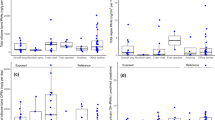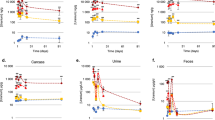Abstract
US and British forces used depleted uranium (DU) in armor-piercing rounds to disable enemy tanks during the Gulf and Balkan Wars. Uranium particulate is generated by DU shell impact and particulate entrained in air may be inhaled or ingested by troops and nearby civilian populations. As uranium is slightly radioactive and chemically toxic, a number of critics have asserted that DU exposure has resulted in a variety of adverse health effects for exposed veterans and nearby civilian populations. The study described in this paper used mathematical modeling to estimate health risks from exposure to DU during the 1991 Gulf War for both US troops and nearby Iraqi civilians. The analysis found that the risks of DU-induced leukemia or birth defects are far too small to result in an observable increase in these health effects among exposed veterans or Iraqi civilians. The analysis indicated that only a few (∼5) US veterans in vehicles accidentally targeted by US tanks received significant exposure levels, resulting in about a 1.4% lifetime risk of DU radiation-induced fatal cancer (compared with about a 24% risk of a fatal cancer from all other causes). These veterans may have also experienced temporary kidney damage. Iraqi children playing for 500 h in DU-destroyed vehicles are predicted to incur a cancer risk of about 0.4%. In vitro and animal tests suggest the possibility of chemically induced health effects from DU internalization, such as immune system impairment. Further study is needed to determine the applicability of these findings for Gulf War exposure to DU. Veterans and civilians who did not occupy DU-contaminated vehicles are unlikely to have internalized quantities of DU significantly in excess of normal internalization of natural uranium from the environment.
This is a preview of subscription content, access via your institution
Access options
Subscribe to this journal
Receive 6 print issues and online access
$259.00 per year
only $43.17 per issue
Buy this article
- Purchase on Springer Link
- Instant access to full article PDF
Prices may be subject to local taxes which are calculated during checkout







Similar content being viewed by others
References
Araneta M.R.G., Scglangen K.M., Edmonds L.D., Destiche D.A., Merz R.D., Hobbs C.A., et al. Prevalence of birth defects among infants of gulf war veterans in Arkansas, Arizona, California, Georgia, Hawaii, and Iowa. Birth Defects Res A Clin Mol Teratol 2003: 67: 246–260.
Arfsten D.P., Still K.R., and Ritchie G.D. A review of uranium and depleted uranium exposure on reproduction and fetal development. Toxicol Ind Health 2001: 17: 180–191.
Bem H., and Bou-Rabi F. Environmental consequences of depleted uranium use in the 1991 Gulf War. Enviro Int 2003: 30: 123–134.
Bleise A., Danesi P.R., and Burkart W. Properties, use and health effects of depleted uranium (DU): a general overview. J Environ Radioact 2003: 64: 93–112.
Catalinotto J., and Flounders S., In: (Eds). Metal of Dishonor-Depleted Uranium: How the Pentagon Radiates Soldiers & Civilians with DU Weapons, International Action Center: New York NY, 2004.
Cowan D.N., DeFraites R.F., Gray G.C., Goldenbaum M.B., and Wishik S.M. The risk of birth defects among children of Persian Gulf War veterans. N Engl J Med 1997: 336: 1650–1656.
Domingo J.L. Chemical toxicity of uranium. Toxicol Ecotoxicol News 1995: 2: 74–78.
Domingo J.L. Reproductive and developmental toxicity of natural and depleted uranium: a review. Reprod Toxicol 2001: 15: 603–609.
Domingo J.L., Paternain J.L., Llobet J.M., and Corbella J. The developmental toxicity of uranium in mice. Toxicology 1989: 55: 143–152.
Fetter S., and von Hippel F.N. The hazard posed by depleted uranium munitions. Sci Global Security 1999: 8: 125–161.
Guilmette R.A., Parkhurst M.A., Miller G., Hahn F.F., Roszell L.E., Daxon E.G., et al. Human health risk assessment of capstone depleted uranium aerosols. Battelle Pacific Northwest Laboratory report PNWD-3442, October 2004.
Hahn F.F., Guilmette R.A., and Hoover M.D. Implanted depleted uranium fragments cause soft tissue sarcomas in the muscles of rats. Environ Health Perspect 2002: 110: 51–59.
ICRP. ICRP publication 30: Limits of intakes of radionuclides by workers. Pergamon: New York, NY, 1979.
ICRP. ICRP publication 60: 1990 recommendations of the International Commission on Radiological Protection. Pergamon: New York, NY, 1991.
ICRP. ICRP publication 66: Human respiratory tract model for radiological protection. Pergamon: New York, NY, 1994.
ICRP. ICRP publication 69: Age-dependent doses to members of the public from intake of radionuclides: part 3 ingestion dose coefficients. Pergamon: New York, NY, 1995.
Italian Ministry of Defense. Preliminary report - Investigative Commission of the Italian Ministry of Defense on the incidence of malignant neoplasia among military personnel involved in operations in Bosnia and Kosovo, March 2001.
Leggett R.W., and Pellmar T.C. The biokinetics of uranium migrating from embedded DU fragments. J Environ Rad 2003: 64: 205–225.
Marshall A.C. An analysis Of uranium dispersal and health effects using a gulf war case study, Sandia National Laboratories Report SAND2005-4331, July 2005.
Martin F., Earl R., and Tawn E.J. A cytogenetic study of men occupationally exposed to uranium. Br J Ind Med 1991: 48: 98–102.
McClain D.E., Benson K.A., Dalton T.K., Ejnik J., Emond C.A., Hodge S.J., et al. Biological effects of embedded depleted uranium (DU): summary of Armed Forces Radiobiology Research Institute research. Sci Total Environ 2001: 274: 115–118.
McDiarmid M.A., Squibb K., Engelhardt S., Oliver M., Gucer P., Wilson P.D., et al. Surveillance of depleted uranium exposed gulf war veterans: health effects observed in an enlarged friendly fire cohort. J Occup Environ Med 2001: 43: 991–1000.
Mettler F.A., and Upton A.C. Medical effects of ionizing radiation, 2nd ed. WB. Saunders: Philadelphia, PA, 1995.
Miller A.C., Blakely W.F., Livengood D., Whittaker T., Xu J., Ejnik J.W., et al. Transformations of human osteoblast cells to the tumorigenic phenotype by depleted uranium-uranyl chloride. Environ Health Perspect 1998: 106: 465–471.
Miller A.C., Brooks K., Smith J., and Page N. Effect of the militarily-relevant heavy metals, depleted uranium and heavy metal tungsten-alloy on gene expression in human carcinoma cells (HepG2). Mol Cell Biochem 2004: 255: 247–256.
Miller A.C., Xu J., Stewart M., Brooks K., Hodge S., Shi L., et al. Observation of radiation specific damage in human cells exposed to depleted uranium: dicentric frequency and neoplastic transformations as endpoints. Radiat Prot Dosimetry 2002: 99: 275–278.
PAC. Presidential Advisory Committee Presidential Advisory Committee on Gulf War Illnesses, Final Report Chapter 3 2005.
Parkhurst M.A., Szrom F., Guilmette R.A., Holmes T.D., Cheng Y.S., Kenoyer J.L., et al. Capstone depleted uranium aerosols: generation and characterization, Volumes 1 and 2. Pacific Northwest National Laboratory report PNNL-14168 October 2004.
Pellmar T.C., Hogan J.B., Benson K.A., and Landauer M.R. Toxicological evaluation of depleted uranium in rats: six month evaluation point. Armed Forces Radiobiology Research Institute: Bethesda MD, 1998.
Rostker B. Environmental exposure report: depleted uranium in the Gulf (II), Second interim DoD report. 2000179-0000002. Tab B. December. Available: http://www.gulflink.osd.mil/du_ii/[accessed 1 June 2006] 2003.
Royal Society. The health hazards of depleted uranium munitions Part I. The Royal Society: London, UK, 2002a.
Royal Society. The health hazards of depleted uranium munitions Part II. The Royal Society: London UK, 2002b.
Ubios A.M., Braun E.M., and Cabrini R.L. Effect of biophosphonates on abnormal mandibular growth in rats intoxicated with uranium. Health Phys 1998: 75: 610–613.
Ubios A.M., Guglielmotti M.B., Steimetz T., and Cabrini R.L. Uranium inhibits bone formation in physiologic alveolar bone modeling and remodeling. Environ Res 1991: 54: 17–23.
United Nations Environmental Programme. Depleted uranium in bosnia and herzegovina post-conflict environmental assessment. UNEP: Nairobi, Kenya, 2003.
USACHPPM. Depleted uranium human exposure assessment and health risk characterization in support of the environmental exposure report "depleted uranium in the Gulf" of the Office of the Special Assistant to the Secretary Of Defense for Gulf War Illnesses, Medical Readiness and Military Deployments (OSAGWI), Health Risk Assessment (HRA) Consultation no. 26-MF-7555-00D, September 2000.
US Department of Energy. Guide to good practices for occupational radiological protection in uranium facilities, US DOE Standard SAFT-0072 (DRAFT), 2000.
U.S. Environmental Protection Agency. Nickel refinery dust data from the Integrated Risk Information System (IRIS) database, Available: http://www.epa.gov/iris/subst/0272.htm[accessed 1 June 2006] 1999.
Wan B., Fleming J.T., Schultz T.W., and Sayler G.S. In vitro immune toxicity of depleted uranium: Effect on murine macrophages CD4+ T cells, and gene expression profiles. Environ Health Perspect January 2006: 114: 85–91.
Waxweiler V.E., Archer, Rosco R.J., Watanabe A., and Thun M.H. Mortality patterns among a retrospective cohort of uranium mill workers. Proc 16th Midyear Topical Symposium of the Health Physics Society 1983, 428–435.
WHO. Depleted uranium: sources, exposure and health effects, World Health Organization Report WHO/SDE/PHE/01.1. April 2001.
Acknowledgements
This work (Sandia document SAND 2006-4999J) was performed for the US Department of Energy. I am grateful for the review of this analysis by Dr. Celeste Drewien and Dr. Leonard Connell and the support of Dr. Clyde Layne and Dr. Jon Rogers from Sandia National Laboratories National Securities Studies Department. I am also grateful for the review of the medical aspects of this study by Dr. Larry Clevenger from Sandia National Laboratories Medical Department.
Author information
Authors and Affiliations
Corresponding author
Rights and permissions
About this article
Cite this article
Marshall, A. Gulf war depleted uranium risks. J Expo Sci Environ Epidemiol 18, 95–108 (2008). https://doi.org/10.1038/sj.jes.7500551
Received:
Accepted:
Published:
Issue Date:
DOI: https://doi.org/10.1038/sj.jes.7500551
Keywords
This article is cited by
-
The Janus face of uranium in toxicology
Archives of Toxicology (2022)
-
Assessment of uranium concentration in blood of Iraqi females diagnosed with breast cancer
Radiation and Environmental Biophysics (2021)
-
Semen Uranium Concentrations in Depleted Uranium Exposed Gulf War Veterans: Correlations with Other Body Fluid Matrices
Biological Trace Element Research (2019)
-
Medical effects of internal contamination with actinides: further controversy on depleted uranium and radioactive warfare
Environmental Health and Preventive Medicine (2016)
-
Birth defects in Iraq and the plausibility of environmental exposure: A review
Conflict and Health (2012)



